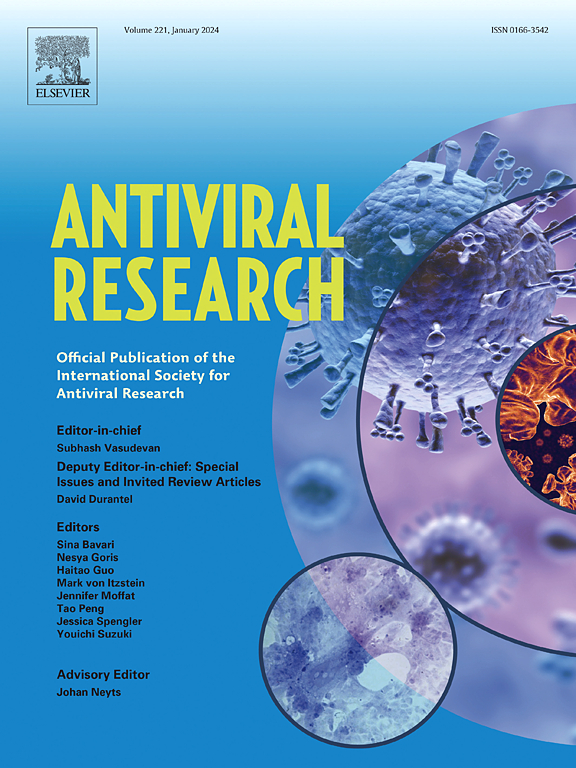2020-2023年流感病毒对神经氨酸酶抑制剂和帽依赖性内切酶抑制剂巴洛昔韦敏感性的全球最新进展
IF 4.5
2区 医学
Q1 PHARMACOLOGY & PHARMACY
引用次数: 0
摘要
流感病毒的抗病毒药物易感性由世界卫生组织全球流感监测和反应系统监测。本研究描述了流感病毒对神经氨酸酶(NA)抑制剂(NAIs,奥司他韦,扎那米韦,peramivir, laninamivir)和帽依赖性核酸酶抑制剂(CENI, baloxavir)的易感性的三个时期(2020-2021年,2021-2022年和2022-2023年5月至5月)的全球分析。特别是,与COVID-19大流行前相比,2020-2021年和2021-2022年全球流感活动性显著下降。基于表型和NA序列的联合分析显示,2020-2021年、2021-2022年和2022-2023年,nai抑制降低或高度降低的季节性流感病毒(RI/HRI)的全球频率仍然较低,分别为0.09%(2/2224)、0.12%(27/23465)和0.23%(124/53917)。与往年一样,甲型H1N1 pdm09病毒中的NA-H275Y是奥司他韦和帕拉米韦引起HRI的最常见替代。基于序列的聚合酶酸性(PA)蛋白分析和表型检测显示,2020-2021年、2021-2022年和2022-2023年,季节性流感病毒的全球频率较低,对巴洛昔韦的敏感性(RS)降低,分别为0.07%(1/1376)、0.05%(9/18380)和0.12% (48/39945);常见的相关替换为PA-I38T/M/L。在日本,2022-2023年的感染率为3.3%(16/488),其中11种A(H3N2)病毒具有PA-I38T/M取代。在人畜共患病毒中,2.7%(3/111)含有与RI/HRI NAI表型相关的NA-H275Y、NA-S247N和NA-N295S各1个取代,没有含有与RS到巴洛昔韦相关的PA取代。总之,绝大多数季节性和人畜共患型流感病毒仍然对NAIs和CENI易感。本文章由计算机程序翻译,如有差异,请以英文原文为准。
Global update on the susceptibilities of influenza viruses to neuraminidase inhibitors and the cap-dependent endonuclease inhibitor baloxavir, 2020–2023
Antiviral susceptibility of influenza viruses is monitored by the World Health Organization Global Influenza Surveillance and Response System. This study describes a global analysis of the susceptibility of influenza viruses to neuraminidase (NA) inhibitors (NAIs, oseltamivir, zanamivir, peramivir, laninamivir) and the cap-dependent endonuclease inhibitor (CENI, baloxavir) for three periods (May to May for 2020–2021, 2021–2022 and 2022–2023). In particular, global influenza activity declined significantly in 2020–2021 and 2021–2022 when compared to the pre-pandemic period of COVID-19. Combined phenotypic and NA sequence-based analysis revealed that the global frequency of seasonal influenza viruses with reduced or highly reduced inhibition (RI/HRI) by NAIs remained low, 0.09% (2/2224), 0.12% (27/23465) and 0.23% (124/53917) for 2020–2021, 2021–2022 and 2022–2023, respectively. As in previous years, NA-H275Y in A(H1N1)pdm09 viruses was the most frequent substitution causing HRI by oseltamivir and peramivir. Sequence-based analysis of polymerase acidic (PA) protein supplemented with phenotypic testing revealed low global frequencies of seasonal influenza viruses with reduced susceptibility (RS) to baloxavir, 0.07% (1/1376), 0.05% (9/18380) and 0.12% (48/39945) for 2020–2021, 2021–2022 and 2022–2023, respectively; commonly associated substitutions were PA-I38T/M/L. In Japan, the rate was 3.3% (16/488) during 2022–2023, with 11 A(H3N2) viruses having PA-I38T/M substitutions. For zoonotic viruses, 2.7% (3/111) contained substitutions, one each NA-H275Y, NA-S247N and NA-N295S, associated with RI/HRI NAI phenotypes, and none contained PA substitutions associated with RS to baloxavir. In conclusion, the great majority of seasonal and zoonotic influenza viruses remained susceptible to NAIs and CENI baloxavir.
求助全文
通过发布文献求助,成功后即可免费获取论文全文。
去求助
来源期刊

Antiviral research
医学-病毒学
CiteScore
17.10
自引率
3.90%
发文量
157
审稿时长
34 days
期刊介绍:
Antiviral Research is a journal that focuses on various aspects of controlling viral infections in both humans and animals. It is a platform for publishing research reports, short communications, review articles, and commentaries. The journal covers a wide range of topics including antiviral drugs, antibodies, and host-response modifiers. These topics encompass their synthesis, in vitro and in vivo testing, as well as mechanisms of action. Additionally, the journal also publishes studies on the development of new or improved vaccines against viral infections in humans. It delves into assessing the safety of drugs and vaccines, tracking the evolution of drug or vaccine-resistant viruses, and developing effective countermeasures. Another area of interest includes the identification and validation of new drug targets. The journal further explores laboratory animal models of viral diseases, investigates the pathogenesis of viral diseases, and examines the mechanisms by which viruses avoid host immune responses.
 求助内容:
求助内容: 应助结果提醒方式:
应助结果提醒方式:


